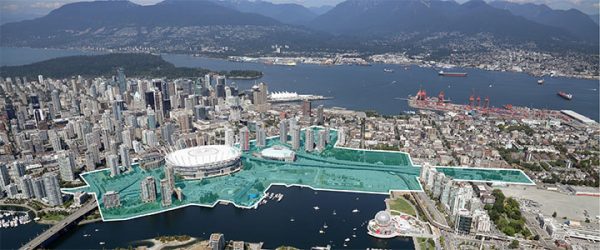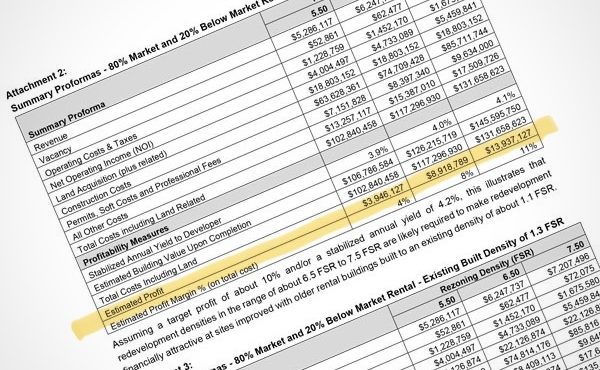The City of Vancouver has released the final plan for Northeast False Creek, which will guide the creation of a vibrant new waterfront destination. The plan provides:
- Vancouver’s largest increase in new and renewed parks and open space in a generation
- One of the most significant deliveries of affordable homes in British Columbia’s history
- The opportunity to reconnect Chinatown and Hogan’s Alley to the rest of the downtown core through a new and improved street network
“This transformative city-shaping project provides a bold new vision for the last remaining downtown waterfront,” says Kevin McNaney, project director for Northeast False Creek. “The plan provides a guide to the evolution of Northeast False Creek into a culturally vibrant waterfront destination to live, work, and play. Comprising 10% of the downtown core, Northeast East False Creek is an opportunity to reimagine an area of former heavy industry and freeway into a renewed place of modern urbanism for people to enjoy.”
Northeast False Creek’s final plan will be going to Council for consideration on January 31.
The plan is the result of some of the most extensive consultation the City has undertaken, including hearing from over 17,500 people at more than 90 events. The City refined the plan to incorporate public feedback and priorities, including a focus on community and social development, housing, reconciliation, and cultural redress.
The Northeast False Creek Area Plan will ensure that public amenities and services continue to meet the community’s needs as Northeast False Creek grows and evolves. The costs of the project, including amenities such as childcare, social housing, artist space, plazas, and a new cultural centre, will be covered by developer-related revenues, utilities, sale or lease of City lands, and strategic partnership agreements with not-for-profit organizations.
Park design consultation continues
The Vancouver Park Board is currently engaging with local First Nations, Chinatown residents, and other area stakeholders on the design of Creekside Park and Andy Livingstone Park, and expects to share the refined concept plan with the public in the spring of 2018.
“We are pleased to be working closely with the Musqueam, Squamish, and Tsleil-Waututh Nations, and Urban Indigenous communities, to ensure that Indigenous principles of cultural practice, ecological stewardship, and visibility on their own lands are reflected in the refined park concept design,” says Malcolm Bromley, general manager of the Vancouver Park Board.
Northeast False Creek’s highlights and opportunities
Housing
The plan will deliver approximately 1,800 affordable homes, one of the largest deliveries of affordable housing in British Columbia’s history. Providing a range of diverse housing options will contribute to a strong downtown, a more equitable city for people with a range of income levels, and a healthy, vibrant, and inclusive neighbourhood.
Parks
The Northeast False Creek Plan proposes to enhance parks and open spaces in the area, connecting seamlessly with the waterfront and surrounding neighbourhoods. The plan includes approximately 32 acres of new and renewed parks, including the new 11-acre Creekside Park, a new ‘destination’ park which will be the largest built in decades. The last time a park was added to city inventory greater than 25 acres was Everett Crowley Park (94.3 acres) in 1987.
The new park space will have a range of flexible and multipurpose spaces that can accommodate events, and improve access to a more biodiverse waterfront that supports urban wildlife. Andy Livingstone Park and the existing Creekside Park north of Science World will also be renewed as part of the plan.
Transportation
A new network of streets, which includes replacing the viaducts, will connect people with Northeast False Creek, and offer a safe and accessible network for people, emergency vehicles, and goods movement.
“People driving into the downtown has been steadily decreasing over the last decade while the number of people choosing to walk, drive, and take transit is growing. The new street network in Northeast False Creek will provide Vancouver with a safer and more resilient street network that better serves the new neighbourhood and all residents,” says Jerry Dobrovolny, general manager of Engineering Services. “Our next step is to bring Council an implementation plan and coordinated construction schedule that outlines the build out of new utilities such as water and sewer mains, as well as the removal of the viaducts and construction of a new complete street network.”
Healthy community
As part of the planning process, the City undertook a social impact assessment to identify opportunities to have a positive impact to surrounding communities, including the Downtown Eastside and Chinatown. As a result, the plan features strategies such as providing affordable rental housing both in and outside Northeast False Creek and supporting local food sources. It also provides new community facilities such as a new ice rink, community centre, and arts pavilion.
Reconciliation and cultural redress
Northeast False Creek is located adjacent to the Downtown Eastside which has a significant Urban Indigenous Community, is part of the Chinatown Community, and was historically the heart of Vancouver’s Black Community (formerly known as Hogan’s Alley). The plan identifies opportunities to recognize these communities by providing cultural gathering spaces, conserving and commemorating living heritage in Chinatown, and reconnecting Chinatown and Hogan’s Alley with the rest of the downtown core.
What’s next?
The Northeast False Creek Plan is going to Council on January 31 and, if approved, will set the long-term vision for the area. The City will then undertake an implementation report for funding approval to deliver on the items in the plan, including the transportation and utility work, as well as ongoing rezoning.
The approval of the Northeast False Creek Plan does not mean an end to the planning process. The City will continue to work with residents and the dozens of dedicated community leaders on the details required for implementing the vision of the plan.
***
For more information, visit the City of Vancouver website.





